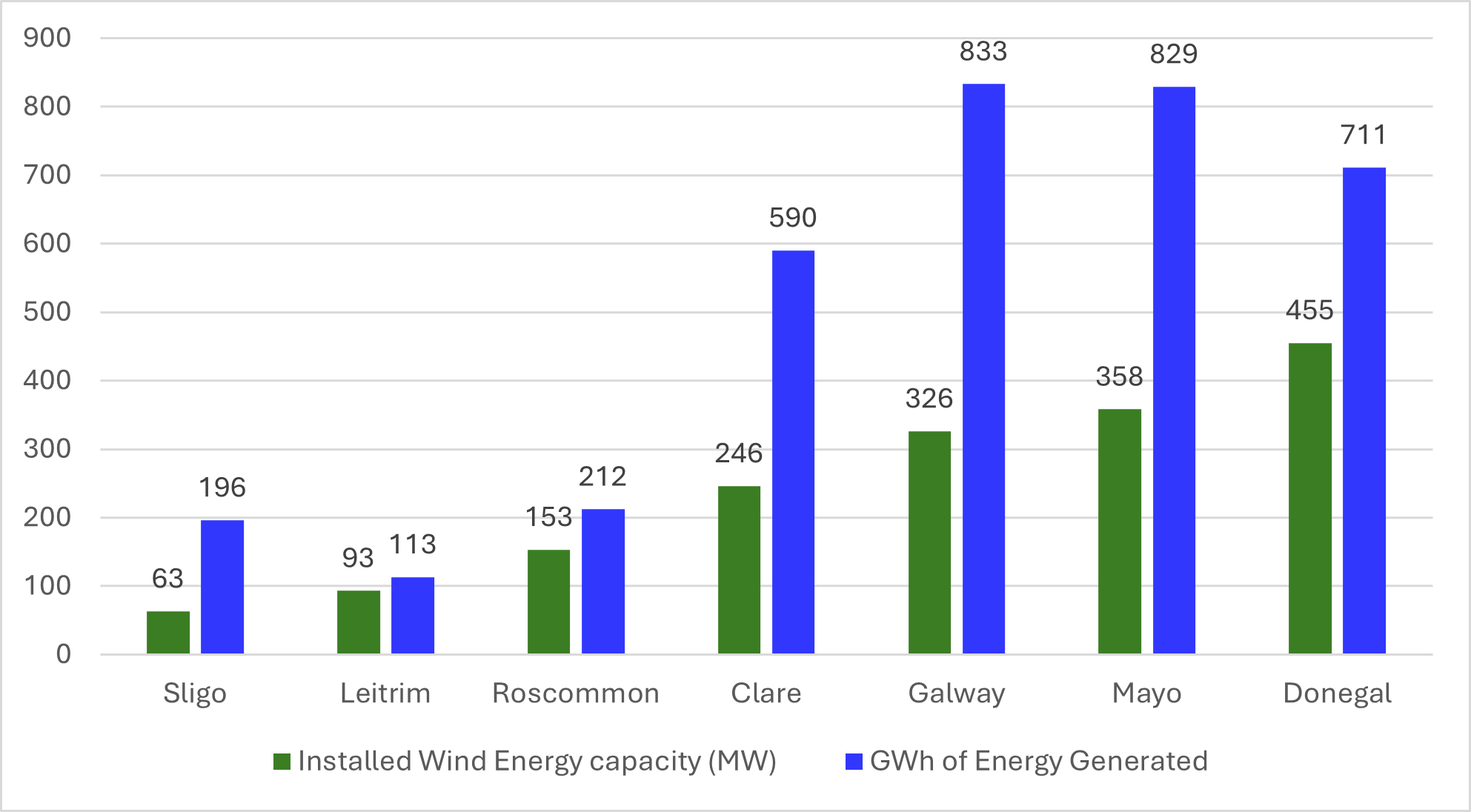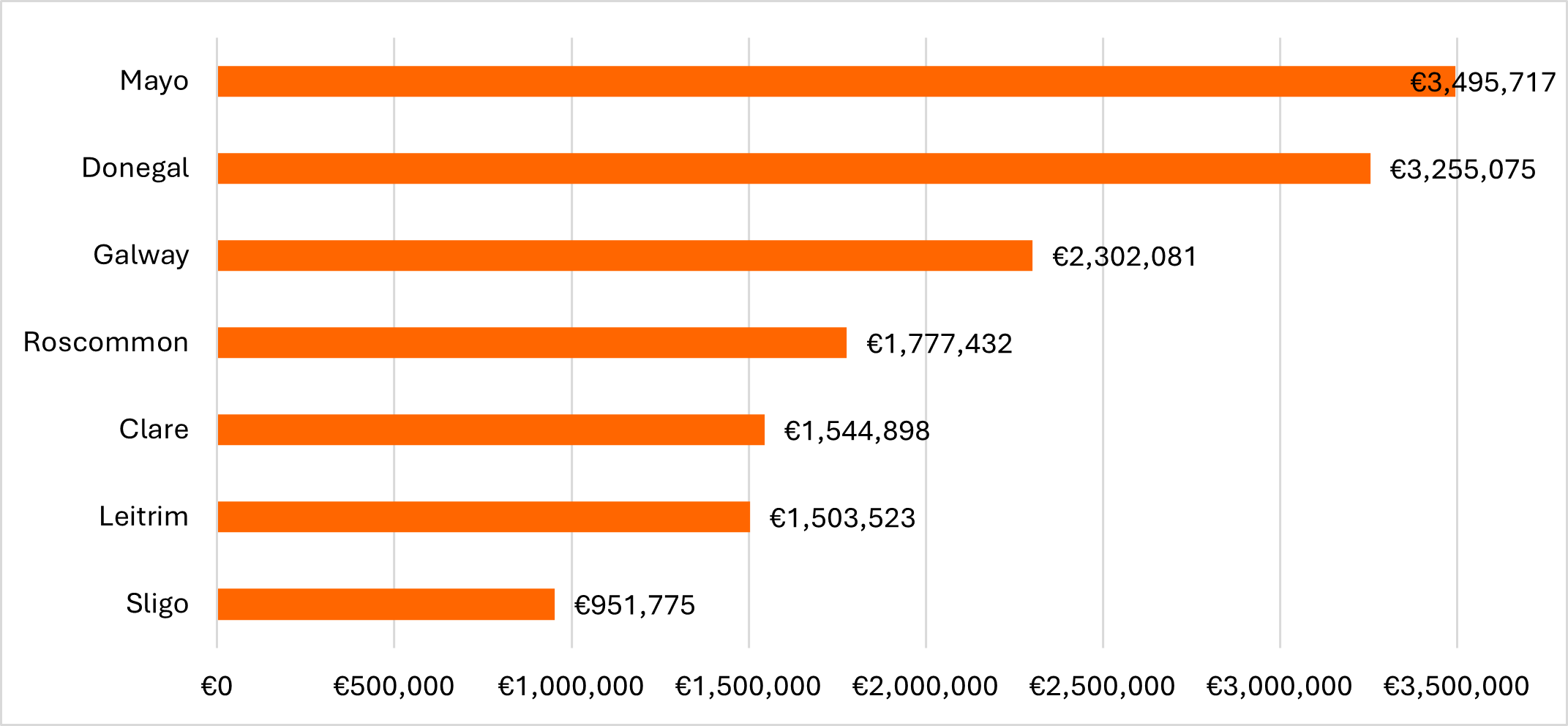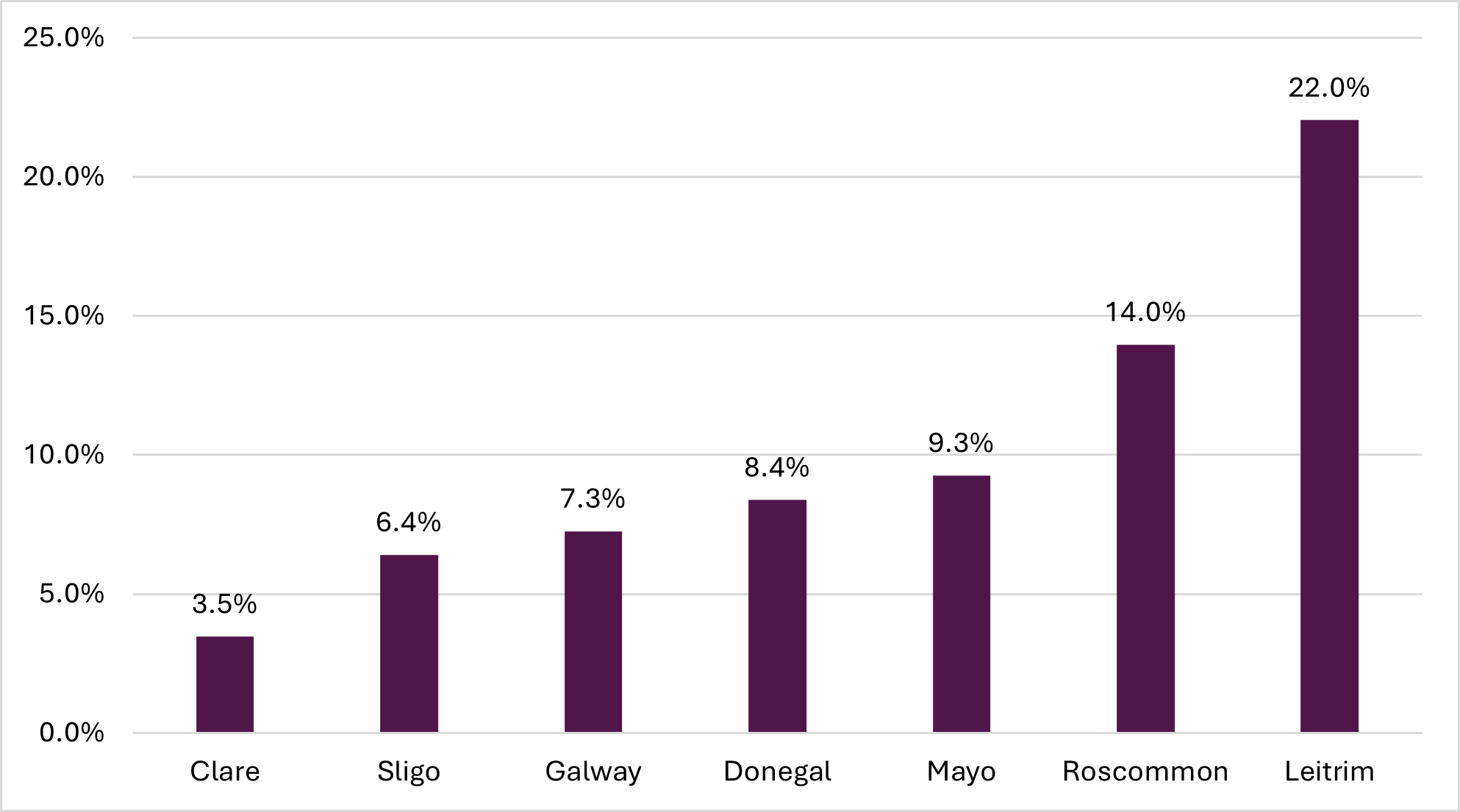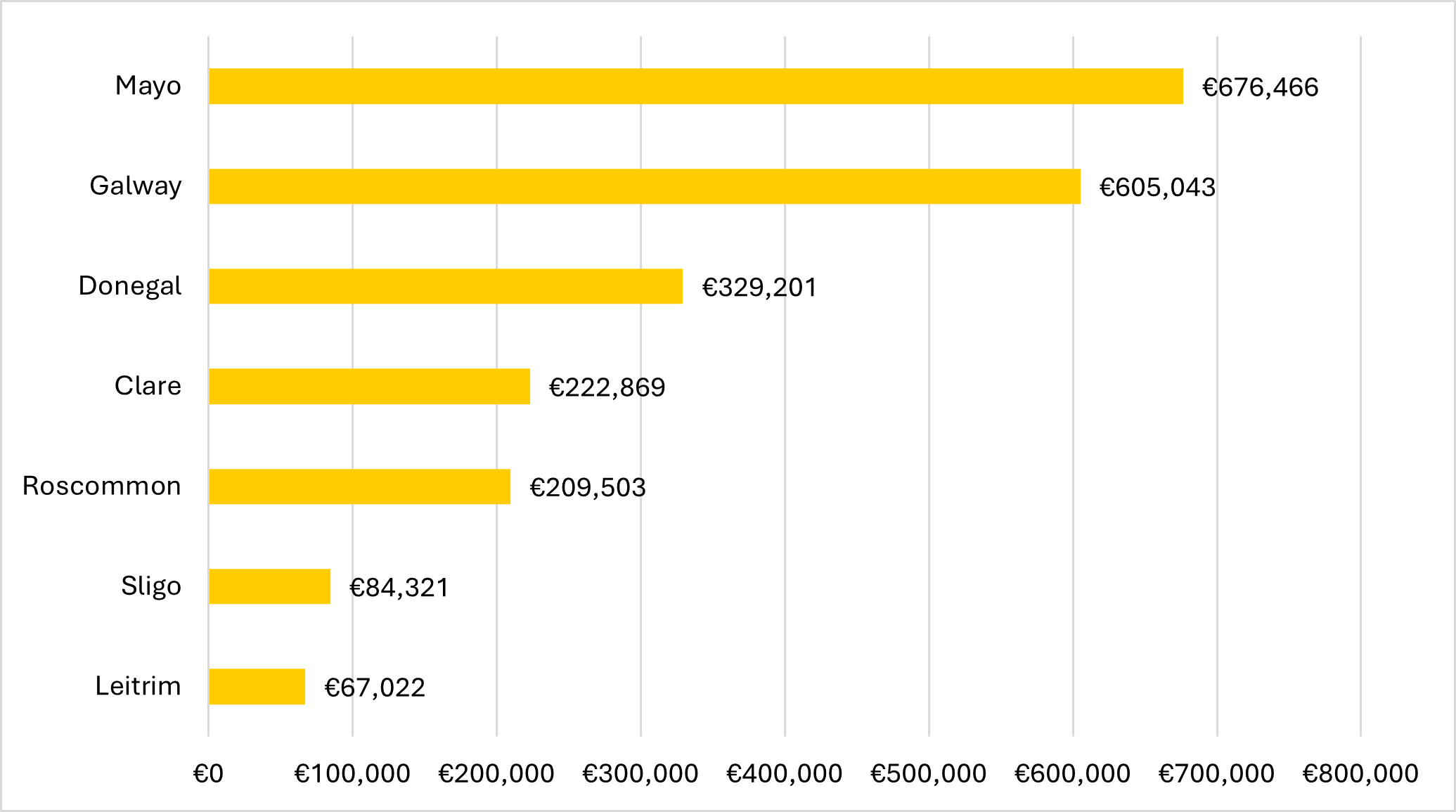The Western Region has significant wind energy resources and a long history of generation at remote locations (Gweedore, Bellacorrick and Screebe, for example) so it is interesting to examine current wind generation in the seven Western Region counties along with some of its associated benefits. Wind Energy Ireland (WEI) has recently published useful data at county level including on the direct economic benefits from commercial rates and local community benefit funds. In this post I look at the data for the seven Western Region counties focusing on installed capacity and generation, commercial rate payments to the local authorities and community benefits payments by county.
Onshore wind energy and payment data from WEI is published on a county by county basis for all of the counties in Ireland. The data is largely from 2024 but the full WEI data note is below*.
Installed Wind Energy capacity (MW) and GWh of energy generated
WEI figures show the combined Western Region counties have 1,694MW of installed capacity (see Figure 1) which is 29% of installed capacity nationally. Donegal has 455 MW installed, the third highest nationally, with Mayo in fifth place (358MW), Galway in sixth place (326 MW) and Clare in seventh place with 246 MW installed (as shown by the WEI county data). For comparison Kerry has the largest installed capacity with 746 MW while Cork is in second place with 705 MW.
Figure 1: Installed Wind Energy capacity (MW) and GWh of energy generated
Source: https://windenergyireland.com/about-wind/wind-energy-by-county
Roscommon (12th nationally), Leitrim (14th) and Sligo (15th) have much lower levels of installed capacity. Interestingly three counties in Ireland (Kildare, Longford and Westmeath) do not have any onshore wind projects.
Data are also provided for energy generated by county, with Western Region counties accounting for 36% of onshore wind energy generated. However, there are some areas of concern. Despite having the highest installed capacity in the Western Region (and third highest in Ireland) Donegal is not in the top five for energy generated nationally, it is in 6th place for energy generated, behind both Galway and Mayo. WEI county figures show Donegal generating 711 GWh, but Galway (833 GWh) and Mayo (829 GWh) produced more.
Counties in the south west with comparable wind resources but fewer transmission infrastructure deficits, perform relatively better for energy generated. Tipperary which is in 4th place for installed capacity (422 MW) is the 3rd highest producer with 890 GWh, Kerry (1,664 GWh) and Cork (1,421 GWh) are in first and second place. Donegal which has some of the best wind resources in the country and was previously the leader in installed capacity now has lower than expected levels of generation. This is indicative of the high level of curtailment affecting the northwest arising from lack of sufficient transmission infrastructure. Data on constraints for 2023 (shown here) indicate 11.4% of generation was constrained in the northwest (corresponding to Donegal) in 2023, with 8.7% constrained in the west (equivalent to the other six Western Region counties) while in the south west the constraint level was 2.3%. See this article for more detailed discussion of the issue in Donegal and here for an explanation of constraints.
Contributions to Commercial Rates
Wind farms make significant contributions to the Local Authority commercial rates in the county in which they are located; in the Western Region this amounts to a total payment of €14,830,501. According to this WEI data shown in Figure 2, Mayo has the highest commercial rate contribution from wind farms (€3,495,717) in the Western Region (5th nationally) followed by Donegal in 6th place nationally (€3,255,075).
Figure 2: Wind farms contribution of the local authority commercial rate income.
Source: https://windenergyireland.com/about-wind/wind-energy-by-county
The amounts are significant in a Western Region context, but nationally Cork had the highest wind farm contribution to commercial rates (€7,497,882) followed by Tipperary (€5,824,297) and Kerry (€5,098,945).
While these amounts are substantial, it is also useful to examine how important these contributions are to each local authority. Figure 3 shows this for the Western Region, with Leitrim standing out as wind farms account for more than a fifth of commercial rates for that local authority. Nationally the importance of the contribution in Leitrim is followed by that in Offaly (18%) and Tipperary (almost 16%) and then Roscommon (14%).
Figure 3: Wind Farm Rates as % of Total County Rates
Source: https://windenergyireland.com/about-wind/wind-energy-by-county
Unsurprisingly the contribution is most important in the more rural counties without large urban centres where there are fewer sources of commercial rates. Wind farms contribution to these local authorities’ commercial rates provide a very important source of funding for these counties.
Local Community Benefit Funds
In addition to providing direct local economic benefit through commercial rates to each local authority, many wind farms have also established local community benefit funds. These make a significant contributions at local level in particular to the achievement of Sustainable Development Goals. (SDGs) but a wide variety of projects may be supported. See here for examples and more information on Community Benefit Funds.
Looking nationally Mayo has the highest community benefit fund investment in Ireland followed by Cork and Offaly. Figure 4 shows the contributions in the Western Region counties. Galway has the fourth largest amount nationally and Donegal is in seventh place. Roscommon is in tenth place, Sligo in twelfth and Leitrim fifteenth.
Figure 4: Invested in Local Community Benefit Funds
Source: https://windenergyireland.com/about-wind/wind-energy-by-county
To some extent the level of community benefit depends on when the associated wind farm projects were commissioned, as the establishment of community benefit funds is a more recent trend. Amounts are also dependent on the developers involved, with some more like to fund community benefits. Under the REFIT programme of support for onshore wind energy (which closed to new applications in 2015 but still supports existing projects) there was no developer requirement to establish a community benefit fund. Under the Renewable Electricity Support Scheme (RESS), which commenced in 2020, all renewable electricity generation projects must establish a Community Benefit Fund to be used for the wider economic, environmental, social and cultural well-being of the local community. The contribution is set at €2 per Megawatt hour of generation of the RESS Project. Thus we can expect the community benefit funds and associated local benefit to grow as more RESS projects are commissioned.
Conclusion
The economic benefits in terms of direct payments into Western Region counties are clear. However, as the WDC has noted many times (see for example here, here and here for our most recent comments) lack of transmission infrastructure, particularly in the north west and west, is limiting the amount of electricity which can be generated and the further development of on shore wind in the region. This is a lost opportunity as we are unable to realise the full potential for renewable energy and our valuable Western Region wind resource.
Helen McHenry
*The following is the WEI note on the data used:
1 GWh of electricity is equivalent to the total annual electricity consumption of around 240 homes. Some of these figures are from 2023. County-level wind generation data is provided by Green Collective. County-level wind generation is calculated by identifying the location of individual wind farms registered with SEMO and aggregating generation data. Please note small wind farms are not required to register with SEMO and, as a result, some of the county-level generation cannot be shown here. Community benefit funds invested in communities are a direct result of the electricity generated.









